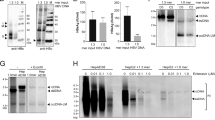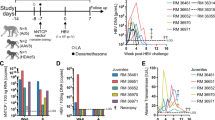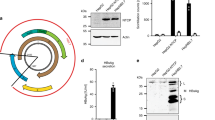Abstract
360 million people are chronically infected with the human hepatitis B virus (HBV) and are consequently prone to develop liver cirrhosis and hepatocellular carcinoma1. As approved therapeutic regimens—which modulate patients' antiviral defenses or inhibit the viral reverse transcriptase—are generally noncurative, strategies interfering with other HBV replication steps are required. Expanding on our demonstration that acylated peptides derived from the large HBV envelope protein block virus entry in vitro2,3,4,5, we show their applicability to prevent HBV or woolly monkey hepatitis B virus infection in vivo, using immunodeficient urokinase-type plasminogen activator (uPA) mice repopulated with primary human or Tupaia belangeri hepatocytes6,7. Accumulation of the peptides in the liver, their extraordinary inhibitory potency and specific mode of action permit subcutaneous delivery at very low doses. Inhibition of hepadnavirus entry thus constitutes a therapeutic approach to prevent primary HBV infection, such as after liver transplantation, and might also restrain virus spread in chronically infected patients.
This is a preview of subscription content, access via your institution
Access options
Subscribe to this journal
Receive 12 print issues and online access
$209.00 per year
only $17.42 per issue
Buy this article
- Purchase on Springer Link
- Instant access to full article PDF
Prices may be subject to local taxes which are calculated during checkout




Similar content being viewed by others
References
Shepard, C.W., Simard, E.P., Finelli, L., Fiore, A.E. & Bell, B.P. Hepatitis B virus infection: epidemiology and vaccination. Epidemiol. Rev. 28, 112–125 (2006).
Engelke, M. et al. Characterization of a hepatitis B and hepatitis delta virus receptor binding site. Hepatology 43, 750–760 (2006).
Glebe, D. et al. Mapping of the hepatitis B virus attachment site by use of infection-inhibiting preS1 lipopeptides and tupaia hepatocytes. Gastroenterology 129, 234–245 (2005).
Gripon, P. et al. Infection of a human hepatoma cell line by hepatitis B virus. Proc. Natl. Acad. Sci. USA 99, 15655–15660 (2002).
Gripon, P., Cannie, I. & Urban, S. Efficient inhibition of hepatitis B virus infection by acylated peptides derived from the large viral surface protein. J. Virol. 79, 1613–1622 (2005).
Dandri, M. et al. Repopulation of mouse liver with human hepatocytes and in vivo infection with hepatitis B virus. Hepatology 33, 981–988 (2001).
Dandri, M. et al. Chronic infection with hepatitis B viruses and antiviral drug evaluation in uPA mice after liver repopulation with tupaia hepatocytes. J. Hepatol. 42, 54–60 (2005).
Root, M.J. & Steger, H.K. HIV-1 gp41 as a target for viral entry inhibition. Curr. Pharm. Des. 10, 1805–1825 (2004).
Chan, H.L. & Sung, J.J. Hepatocellular carcinoma and hepatitis B virus. Semin. Liver Dis. 26, 153–161 (2006).
Zoulim, F. Antiviral therapy of chronic hepatitis B. Antiviral Res. 71, 206–215 (2006).
Seeger, C. & Mason, W.S. Hepatitis B virus biology. Microbiol. Mol. Biol. Rev. 64, 51–68 (2000).
Bruss, V. Hepatitis B virus morphogenesis. World J. Gastroenterol. 13, 65–73 (2007).
Gripon, P., Le, S.J., Rumin, S. & Guguen-Guillouzo, C. Myristylation of the hepatitis B virus large surface protein is essential for viral infectivity. Virology 213, 292–299 (1995).
LeSeyec, J., Chouteau, P., Cannie, I., Guguen-Guillouzo, C. & Gripon, P. Infection process of the hepatitis B virus depends on the presence of a defined sequence in the pre-S1 domain. J. Virol. 73, 2052–2057 (1999).
Glebe, D. & Urban, S. Viral and cellular determinants involved in hepadnaviral entry. World J. Gastroenterol. 13, 22–38 (2007).
Dandri, M., Lutgehetmann, M., Volz, T. & Petersen, J. Small animal model systems for studying hepatitis B virus replication and pathogenesis. Semin. Liver Dis. 26, 181–191 (2006).
Sandgren, E.P. et al. Complete hepatic regeneration after somatic deletion of an albumin-plasminogen activator transgene. Cell 66, 245–256 (1991).
Schmitz, J., Ohme, M. & Zischler, H. The complete mitochondrial genome of Tupaia belangeri and the phylogenetic affiliation of scandentia to other eutherian orders. Mol. Biol. Evol. 17, 1334–1343 (2000).
Kock, J. et al. Efficient infection of primary tupaia hepatocytes with purified human and woolly monkey hepatitis B virus. J. Virol. 75, 5084–5089 (2001).
Lanford, R.E., Chavez, D., Brasky, K.M., Burns, R.B. III & Rico-Hesse, R. Isolation of a hepadnavirus from the woolly monkey, a New World primate. Proc. Natl. Acad. Sci. USA 95, 5757–5761 (1998).
Urban, S. & Gripon, P. Inhibition of duck hepatitis B virus infection by a myristoylated pre-S peptide of the large viral surface protein. J. Virol. 76, 1986–1990 (2002).
Volz, T. et al. Impaired intrahepatic Hepatitis B virus productivity contributes to low viremia in most HBeAg-negative patients. Gastroenterology 133, 843–852 (2007).
Freireich, E.J., Gehan, E.A., Rall, D.P., Schmidt, L.H. & Skipper, H.E. Quantitative comparison of toxicity of anticancer agents in mouse, rat, hamster, dog, monkey, and man. Cancer Chemother. Rep. 50, 219–244 (1966).
Locarnini, S. et al. Management of antiviral resistance in patients with chronic hepatitis B. Antivir. Ther. 9, 679–693 (2004).
Barrera, A., Guerra, B., Notvall, L. & Lanford, R.E. Mapping of the hepatitis B virus pre-S1 domain involved in receptor recognition. J. Virol. 79, 9786–9798 (2005).
Dandri, M. & Petersen, J. Hepatitis B virus cccDNA clearance: killing for curing? Hepatology 42, 1453–1455 (2005).
Taylor, J.M. Hepatitis delta virus. Virology 344, 71–76 (2006).
Glebe, D. Attachment sites and neutralising epitopes of hepatitis B virus. Minerva Gastroenterol. Dietol. 52, 3–21 (2006).
Werle-Lapostolle, B. et al. Persistence of cccDNA during the natural history of chronic hepatitis B and decline during adefovir dipivoxil therapy. Gastroenterology 126, 1750–1758 (2004).
Schulze, A., Gripon, P. & Urban, S. Hepatitis B virus infection initiates with a large surface protein-dependent binding to heparan sulfate proteoglycans. Hepatology 46, 1759–1768 (2007).
Acknowledgements
We thank P. Gripon and J. Taylor for many helpful discussions, R. Bartenschlager for continuous support and critical reading of the manuscript, R. Reusch, N. Jaeger and H. Eskerski for excellent animal care and C. Kuhn for help with the cryosections. This work was supported by the German Competence Network for Viral Hepatitis (Hep-Net), funded by the German Ministry of Education and Research (BMBF), grant no. 01 KI 0418. S.U. and J.P. were supported by the Deutsche Forschungsgemeinschaft (DFG), grant no. UR72/1-3, UR72/1-4 and Pe608/2-5. J.P. was also supported by the European Union Vigilance Network for the management of antiviral drug resistance (Virgil).
Author information
Authors and Affiliations
Contributions
J.P. and M.D. designed research, analyzed data and wrote the manuscript; W.M. and U.H. synthesized and labeled peptides and performed biodistribution experiments; M.L. performed transplantation experiments and immunohistochemistry; T.V. performed transplantation experiments and molecular assays; F.v.W. provided Tupaia belangeri hepatocytes; L.F. and J.-M.P. provided human hepatocytes; B.E. performed in situ biodistribution experiments; S.S. purified HBV virus stocks and analyzed data; S.U. initiated and designed research, analyzed data and wrote the manuscript.
Corresponding author
Supplementary information
Supplementary Text and Figures
Supplementary Figures 1–4 (PDF 1893 kb)
Rights and permissions
About this article
Cite this article
Petersen, J., Dandri, M., Mier, W. et al. Prevention of hepatitis B virus infection in vivo by entry inhibitors derived from the large envelope protein. Nat Biotechnol 26, 335–341 (2008). https://doi.org/10.1038/nbt1389
Received:
Accepted:
Published:
Issue Date:
DOI: https://doi.org/10.1038/nbt1389
This article is cited by
-
Structural basis of hepatitis B virus receptor binding
Nature Structural & Molecular Biology (2024)
-
Structural basis of sodium-dependent bile salt uptake into the liver
Nature (2022)
-
Curcumin inhibited hepatitis B viral entry through NTCP binding
Scientific Reports (2021)
-
Innate immunity in hepatitis B and D virus infection: consequences for viral persistence, inflammation, and T cell recognition
Seminars in Immunopathology (2021)
-
Role of Nucleic Acid Polymers and Entry Inhibitors in Functional Cure Strategies for HBV
Current Hepatology Reports (2020)



